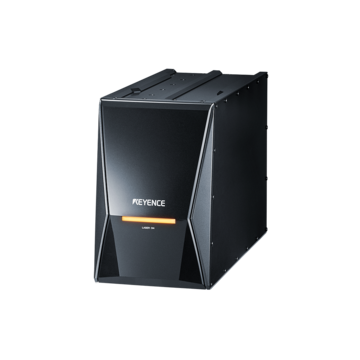Laser Marking Systems / Laser Markers
What Is the Best Laser for Marking Plastic?
-
Tags:
- Plastic , Laser Marking , Medical
Laser marking is a non-contact, non-subtractive process for marking plastics without altering their structural integrity. It produces high-quality marks that are forgery-proof, durable, chemical-resistant, and temperature resistant. Therefore, it makes this an attractive option for manufacturing companies across a range of industries.
Using a laser marking machine for plastic, or plastic engraving machine, creates marks on an array of industrial components. It is the most appropriate technology for etching or marking plastic with serial numbers, barcodes, 2D codes, names or compliance stamps, and logos; plus this non-contact process eliminates the need for pneumatic systems or jigs.
Plastics vary significantly in their chemical makeup and may respond differently to laser marking processes such as etching and engraving, so to get optimal results select a machine compatible with your specific requirements.
In the following, we'll take a look at the process of laser marking plastic, along with our recommendations for the best laser marking machine for plastic to get the job done.
Why is Laser Marking a Great Option for Plastic Materials?
Laser marking plastic is a precise and efficient process that creates permanent, high-quality markings on components. By using a laser beam to remove or modify the surface of the plastic, it creates a permanent mark that is resistant to chemicals, abrasion, and extreme temperatures. Laser marking is cost-effective and environmentally friendly compared to traditional marking methods, making it an attractive option for many.
In addition, processes like dot peen or printing don't always work well when applied to curved surfaces due to ink adhesion issues and poor substrate contrast, while laser marking offers superior flexibility, cost efficiency, and speed, and it avoids the use of costly inks or chemicals.
We’re here to provide you with more details.
Reach out today!

Which Plastics Can Be Laser Marked?
Laser marking can be used on most plastics, although specific methods or treatments may be necessary to achieve the desired result. The most commonly marked plastics include ABS, PBT, and PET.
Laser marking has long been used in industrial settings and, more recently, has also proven itself beneficial to consumer goods like electronics, toys, and automobile components. With precise and accurate marks that laser marking creates, it offers the ideal method of product identification, traceability, and quality assurance.
No matter the industry or plastic being marked, it is crucial that you know which laser is ideal for your application. Selecting an efficient machine will maximise performance while minimising downtime, saving both time and money in the process.
Discover more about this product.
Click here to book your demo.

What Are the Considerations When Marking Plastics?
Marking plastics requires both precision and creativity. Due to the wide array of compounds and additives present in various plastics, traditional marking methods like printing or engraving may prove unsuccessful in producing results that meet expectations.
Laser marking is one of the most efficient ways to produce quality marking on plastic materials. These markings on plastic products cannot be removed with solvent alone and are more durable in harsh environments like salt sprays and UV exposure than any other method, making this technique ideal for industrial marking applications.
Marking plastics requires taking into account the surface texture. Some plastics feature smooth finishes, while others possess textured or matte textures that require specific settings in laser software to avoid creating holes in their marks.
Finally, when selecting a laser system, it is important to consider the design of the components that need to be marked. Any part that is not flat will likely require a 3-Axis Laser marking system to retain focus and provide a quality mark.
We’re here to provide you with more details.
Reach out today!

The Different Types of Marking on Plastics
When it comes to laser marking plastic, various techniques and technologies can be used to meet specific needs. Here are a few common methods and their characteristics:
UV Laser Marking
UV laser marking is a popular method for marking plastics across many industries. Its ability to create high-quality, precise, and permanent marks without causing damage to the surface makes it an attractive choice. UV lasers operate at a wavelength absorbed well by many plastics. This allows for efficient marking without the need for excessive heat and without damage to the surface or components. UV laser marking is especially effective for applications that require fine details, high contrast, and durability.
CO2 Laser Marking
CO2 laser marking involves the use of a high-powered CO2 laser beam to mark plastic surfaces. This method relies on heat to create the desired mark. CO2 lasers are known for their speed and efficiency in marking plastics. However, the marks produced by CO2 lasers may not exhibit high contrast, making them less suitable for applications that require clear visibility or readability.
Fibre / Hybrid Laser Marking
Fibre and hybrid laser marking methods utilise lasers with different wavelengths to achieve contrasting marks on plastics. These lasers thermally process the surface of the material, creating contrast by altering the colour or texture. Fibre lasers are often preferred for their ability to mark a wide range of plastics and create high-quality, visible marks. However, it is important to note that there is potential risk of thermal damage. This is especially true when working with heat-sensitive plastics.
It's critical to consider the specific requirements of the application, including durability, readability, contrast, and potential thermal damage risks when selecting a marking method for plastics. Each method has its advantages and considerations, and manufacturers should choose the most suitable technique based on the desired outcome and the characteristics of the plastic material being marked.
Now that we understand the types of marking on plastic parts, figuring out the best equipment for the job, like a laser marking machine for plastic, is the final step.
Curious about our pricing?
Click here to find out more.

Best Laser for Marking Plastic
There are a few common methods for marking plastic, each requiring a specific laser marking machine for plastic. For dark marking on plastic, our 3-Axis Hybrid Laser Marker will create beautiful marks on light-coloured plastics. For white marking applications, the same laser markers are recommended to add light marks to dark-coloured plastic components.
Another common plastic laser marking application is applying lot/date codes in the food and packaging industries. Things like water or soda bottles generally use the ML-Z Series CO2 laser marker because it is able to keep up with tight cycle time demands while still producing a clean, readable mark.
Regardless of the industry or application requirements, KEYENCE offers a wide range of laser markers for plastic, helping you find the perfect system for your needs. For more information and to narrow your search for a laser marking machine for plastic based on material, application, or industry, take a look at our laser marking plastic page or call us at 1-800-88-1358 today.
Contact us to learn more about how our advanced technology can help take your business to the next level.
Contact Us





